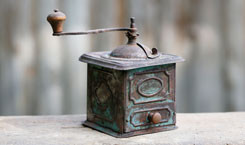Arabic wine spreads in Europe
Even earlier, Middle Eastern travelers reported on the stimulating "Arabic wine," the coffee of the Orient. First as a popular souvenir and then first imported in Venice, Europeans quickly learned to appreciate the benefits of the new fashionable drink. Contrary to popular belief, it was not Vienna but Venice that was the cradle of coffee in Europe. After Europe's first coffee house opened in Venice in 1647 (still to be found today in St. Mark's Square) and quickly secured a monopoly on coffee imports, Italy's now world-famous roasting craft developed. The term "espresso" was also coined here.
It was not until forty years and many cities later that an Armenian opened the first Viennese coffee house with 50 sacks of coffee left over from the Turkish siege of Vienna. Through the expansion of the European colonial powers, coffee reached the whole world in the course of the 17th century. Latin America, Asia, large parts of Africa, and many other tropical and subtropical areas turned out to be excellent substitute homes for the coffee plant, and coffee imported by the colonial masters soon replaced Yemeni coffee. Introduced to Brazil by Portuguese colonialists in 1727, the country is now the largest producer and consumer of coffee in the world.
The good name
Coffee that calls itself "Mocha" is not necessarily of superior quality, just like the popular "Brazil Santos," but was merely transshipped in the port of Mocha or the Brazilian port of Santos.
Even the label "100% Arabica" does not necessarily mean that only high-quality beans were used; only about 5% of the world's Arabica harvest is of truly top quality.

